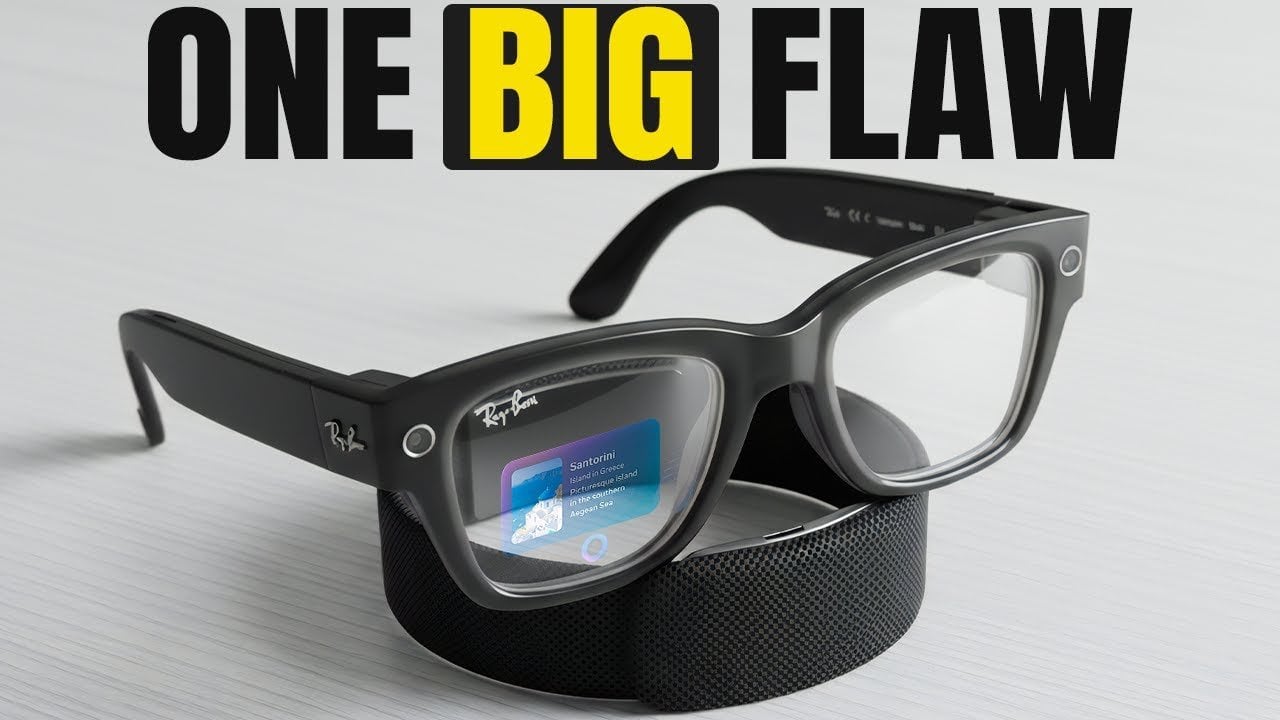What if the future of wearable tech isn’t as seamless as it seems? Meta’s $800 Ray-Ban display glasses promise a innovative blend of style and innovation, but beneath the sleek aluminum frame lies a product riddled with compromises. From a single-eye display that can cause discomfort to a neural wristband that’s as impractical as it is new, these glasses may not live up to their futuristic allure. While Meta touts its advancements, early adopters are uncovering issues that leave many questioning whether the hefty price tag is justified, or if competitors like Rokid, with their more balanced approach, are quietly outpacing the tech giant.
Below Gadget Evolution take a closer look at what Meta isn’t telling you about its Ray-Ban display glasses. You’ll discover how their design flaws, restrictive prescription lens options, and reliance on accessories like the neural wristband create barriers for everyday use. At the same time, we’ll highlight the features that do shine, such as the glasses’ impressive camera system, while contrasting them with alternatives that prioritize usability over flash. By the end, you might find yourself reconsidering what truly defines innovation, and whether Meta’s vision for smart glasses aligns with your own.
Meta Ray-Ban Glasses
TL;DR Key Takeaways :
- Meta’s $800 Ray-Ban display glasses feature advanced technology but face criticism for usability issues, including discomfort from the single-eye display and reliance on a neural wristband.
- The glasses’ high-resolution display suffers from flaws like binocular rivalry, causing headaches and eye strain, especially for left-eye dominant users.
- Prescription lens support is limited, costly, and non-removable, making the glasses impractical for users with evolving vision needs.
- The camera system is a standout feature, offering 12 MP resolution, 4K video recording, and excellent low-light performance, appealing to photography enthusiasts.
- Competitor Rokid offers a more user-friendly and affordable alternative with dual-eye displays, intuitive controls, and replaceable prescription lenses, addressing many of Meta’s shortcomings.
Display Technology: Advanced Yet Flawed
The Ray-Ban display glasses feature a high-resolution display with 5,000 nits of brightness and a resolution of 600×600 pixels at 90 Hz. These specifications are impressive on paper, but the implementation has notable flaws. The display is limited to the right eye, which introduces a phenomenon known as binocular rivalry. This occurs when the brain struggles to process differing inputs from each eye, often resulting in discomfort such as headaches, eye strain, and nausea.
For the approximately 30% of the population who are left-eye dominant, the single-eye display design presents even greater challenges, rendering the glasses nearly unusable for these individuals. While the display technology itself is undeniably advanced, its design fails to account for critical physiological and ergonomic factors. This oversight has left many users dissatisfied, highlighting the need for a more inclusive and user-friendly approach.
Neural Wristband: Innovative but Impractical
One of the most distinctive features of Meta’s glasses is the neural wristband, which detects muscle signals to enable gesture-based controls. While this technology represents a significant innovation, it comes with several practical drawbacks. Users report that the wristband must be worn tightly for accurate gesture detection, which can cause discomfort during extended use. Additionally, the system often misinterprets gestures, leading to frustration and inconsistent performance.
The reliance on the wristband also creates a single point of failure. If the wristband malfunctions, is lost, or becomes damaged, the glasses lose much of their functionality. This dependency significantly reduces the practicality of the device for everyday use, making it less appealing for consumers who prioritize reliability and ease of use.
Meta’s AI Glasses Are They Worth the Hype or Just a Pricey Gimmick?
Explore further guides and articles from our vast library that you may find relevant to your interests in smart glasses.
Prescription Lens Support: A Costly Limitation
Meta’s glasses offer support for prescription lenses, but the implementation has several limitations. The lenses are restricted to prescriptions between -4 and +4 diopters, excluding users with stronger vision needs. Additionally, the lenses are non-removable and come with an extra cost of $200, with manufacturing taking several weeks.
This design creates long-term usability challenges. If a user’s prescription changes, the glasses become obsolete, forcing them to purchase a new pair. For a product priced at $800, such limitations are a significant drawback, particularly for users with evolving vision requirements. The inability to easily replace or upgrade the lenses adds to the overall inconvenience, making the glasses less appealing for a broader audience.
Camera System: A Bright Spot
One of the standout features of the Ray-Ban glasses is their camera system, which delivers exceptional performance. Equipped with a 12 MP camera capable of 4K video recording, 3x zoom, and advanced stabilization, the glasses produce high-quality images and videos. The camera performs particularly well in low-light conditions, offering professional-grade results that set it apart from many competitors.
While the camera system is undoubtedly a strong point, it cannot fully compensate for the glasses’ other shortcomings. For users seeking a comprehensive smart glasses experience, the camera alone may not justify the high price tag. However, for those prioritizing photography and videography, this feature may hold significant appeal.
Build Quality and AI Features: Premium Materials, Limited Usability
Meta has invested in premium materials for the Ray-Ban glasses, including an aluminum frame, sapphire lens, and titanium bezel. These materials contribute to a sleek and durable design, giving the glasses a high-end aesthetic. Additionally, the glasses feature advanced AI capabilities, such as live translation, repair instructions, and recipe guidance, which enhance their functionality and appeal to tech-savvy users.
Despite these strengths, the physical design and hardware limitations undermine the overall user experience. The glasses’ ergonomic flaws and reliance on additional accessories, such as the neural wristband, detract from their practicality. While the AI features are impressive, they cannot fully offset the discomfort and usability challenges posed by the device’s design.
Competitor Comparison: Rokid’s Balanced Approach
In contrast to Meta’s offering, Rokid provides a more balanced and user-friendly alternative at a lower price point of $479. Rokid’s glasses feature a dual-eye display with a 144 Hz refresh rate, eliminating the eye strain associated with binocular rivalry. This design ensures a more comfortable and inclusive experience for a wider range of users.
Instead of relying on a neural wristband, Rokid employs intuitive touch controls, which are simpler and more reliable. Prescription lenses are handled more effectively with magnetic inserts that are easily replaceable and accommodate a broader range of vision needs. Additionally, Rokid’s glasses offer comparable camera quality and battery life, along with more practical charging options. These features make Rokid’s glasses a more appealing choice for consumers seeking a well-rounded smart glasses experience.
Balancing Innovation with Usability
Meta’s Ray-Ban display glasses showcase impressive technological advancements but fall short in addressing critical usability and design challenges. The reliance on a single-eye display, restrictive prescription lens system, and neural wristband create significant barriers for everyday users. While the glasses excel in areas like camera performance and material quality, these strengths are overshadowed by their practical limitations.
In contrast, Rokid’s alternative demonstrates that a more balanced approach can deliver a superior user experience at a lower cost. By prioritizing comfort, accessibility, and reliability, Rokid has positioned itself as a strong competitor in the smart glasses market. For consumers, this serves as a reminder that innovative technology must be paired with thoughtful design to truly succeed. As the market for smart glasses continues to evolve, the importance of user-centric innovation will remain a key factor in determining the success of future products.
Media Credit: Gadget Evolution
Filed Under: Technology News, Top News
Latest Geeky Gadgets Deals
Disclosure: Some of our articles include affiliate links. If you buy something through one of these links, Geeky Gadgets may earn an affiliate commission. Learn about our Disclosure Policy.
First Appeared on
Source link













